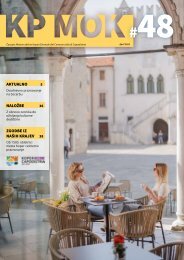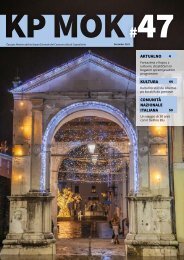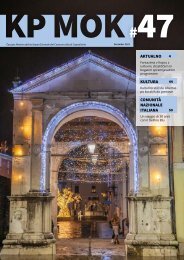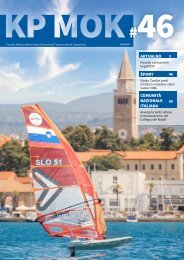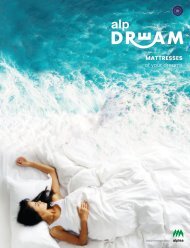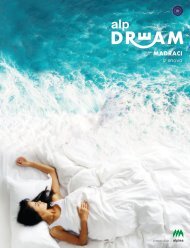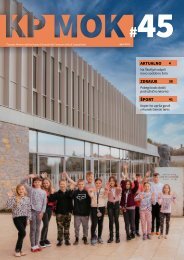EUSAIR - Final Report
You also want an ePaper? Increase the reach of your titles
YUMPU automatically turns print PDFs into web optimized ePapers that Google loves.
And what are these priorities?<br />
Let me list them as they were defined at the time, since<br />
they show very nicely from where the Slovene Presidency<br />
also drew emphasis and inspiration: greening of<br />
blue economic activities and mobility (including transport<br />
logistics), sustainable tourism, sustainable food<br />
production (including fishing), environmental protection<br />
(including the marine environment), capacity building,<br />
preparing for climate change and defining actions to<br />
adapt and mitigate the effects of climate change,<br />
governance of maritime space.<br />
They thus came up with seven framework contents,<br />
which are now among the national priorities of blue<br />
development. It was also emphasized in the discussion<br />
that participants employed in government bodies and<br />
public institutions should pass on these findings to<br />
those responsible. The aim was to guide the various<br />
ministries and government departments to follow national<br />
blue development priorities in policy planning<br />
and day-to-day activities.<br />
The list of “seven glorious” blue developments<br />
ends with the current topical theme of governance<br />
of maritime space ...<br />
Here, the key “breakthrough” took place within the<br />
one-year Slovene Presidency, at Mediterranean<br />
Coast Week last September, in Izola. More precisely,<br />
on 18 September 2020, the spatial maritime plan of<br />
Slovenia was presented in the meeting room of the<br />
municipal building on Kristanov trg. Its key mission is to<br />
promote sustainable growth of the maritime economy<br />
and ensure sustainable use of marine resources. It is<br />
the largest intertwining of the development of activities,<br />
uses and regimes at sea and on the coast. The preparation<br />
of the first Maritime Spatial Plan is based on EU<br />
Directive 2014/89 and the Slovene Spatial Planning Act.<br />
In addition to maritime affairs and fisheries, it covers<br />
ten other activities related to the sea, from mariculture<br />
to nature protection and cultural heritage.<br />
The presented working draft also included warnings<br />
about problematic interventions in space, such as the<br />
planned island in front of Izola, the relocation and disposal<br />
of sea sludge from the area of the Port of Koper<br />
and marinas, and expansion of the coast at Semedela<br />
and Žusterna. In a special chapter, they also focused<br />
on the prevention and management of possible accidents<br />
at sea and the disposal of contaminated material.<br />
At the end of Mediterranean Coast Week, the coordinator<br />
of the <strong>EUSAIR</strong> Environmental Pillar from the Ministry of<br />
the Environment and Spatial Planning, Mr Bricelj, said<br />
that Slovenia had never had such a modern and internationally<br />
verified professional starting point for coastal<br />
and marine management and never in history had there<br />
been so much money available to fund agreed projects<br />
in the <strong>EUSAIR</strong> process.<br />
Perhaps this is one of the reasons why the debate<br />
on the Spatial Maritime Plan has not been without<br />
controversy?<br />
The spatial plan envisages a 150-meter coastal strip<br />
and an approximately 100-meter land strip to be determined<br />
by local communities. It is therefore logical that it<br />
has been the subject of lively public debate, since bringing<br />
long-term sustainable effects still affects many current,<br />
critical relationships. I often say that the Adriatic-Ionian<br />
Region covers almost 70 million people and that it<br />
is an area with many interests, so only cooperation can<br />
meet the needs and desires that we feel in this area.<br />
Let me remind you of the Declaration adopted by entrepreneurs<br />
and craftsmen, scientists, researchers and<br />
representatives of local authorities of the four Slovene<br />
municipalities along the Slovene sea at the problem<br />
conference “Sea, who will love you” on 27 May 2019. In<br />
it, we wrote that in the field of spatial planning and environmental<br />
protection, we expect that the Ministry of the<br />
Environment and Spatial Planning will significantly accelerate<br />
activities in the preparation of an umbrella document<br />
for the sea. “We can’t have everything everywhere on<br />
little more than 40 kilometres of the sea coast, so we need<br />
to determine the purpose of individual parts of the sea,” the<br />
declaration reads. We advocated an important role for<br />
all four municipalities located by the sea. We therefore<br />
established the Council for the Slovene Adriatic. When<br />
we asked the government to set up a working body and<br />
prepare a document, we were in fact anticipating spatial<br />
maritime plans. We wrote that “it must be clear to everyone<br />
where the sea belt is intended for economic activities,<br />
where the areas are intended for tourism, where we can<br />
place shellfish and fish farms, how much sea and where we<br />
will protect.” We also clearly expressed the expectation<br />
that the government and the National Assembly of the<br />
Republic of Slovenia would propose solutions that will<br />
have the consent of local communities. We are again<br />
at the priorities of Blue Growth in Slovenia!<br />
32 | <strong>EUSAIR</strong> Slovene Presidency





